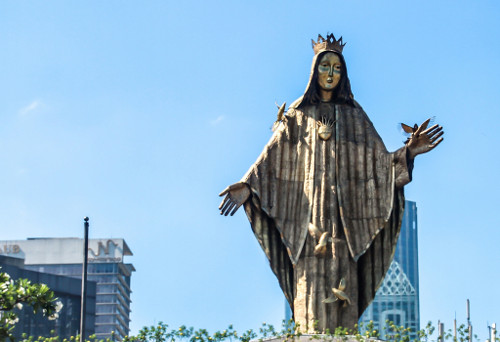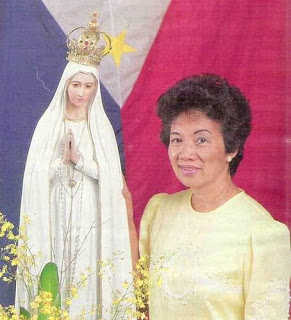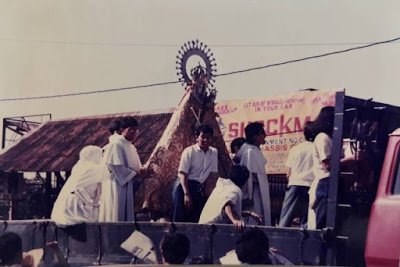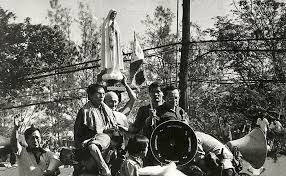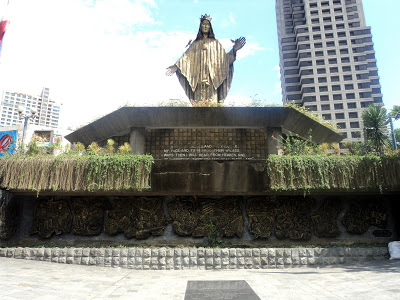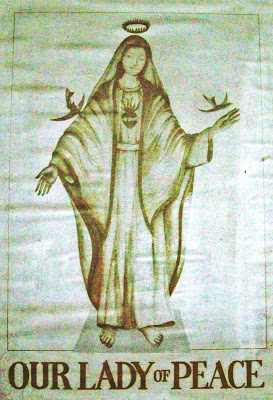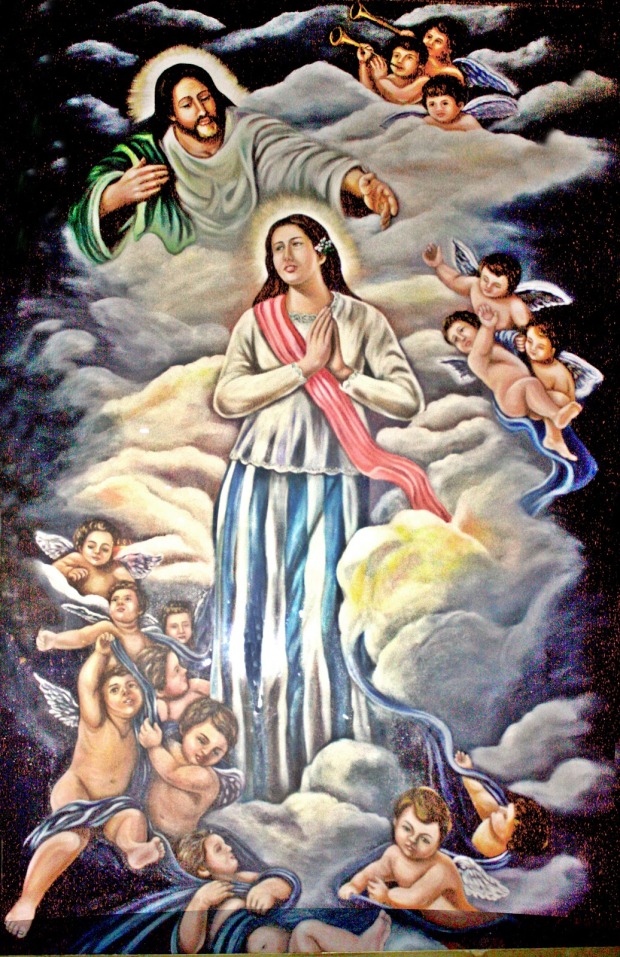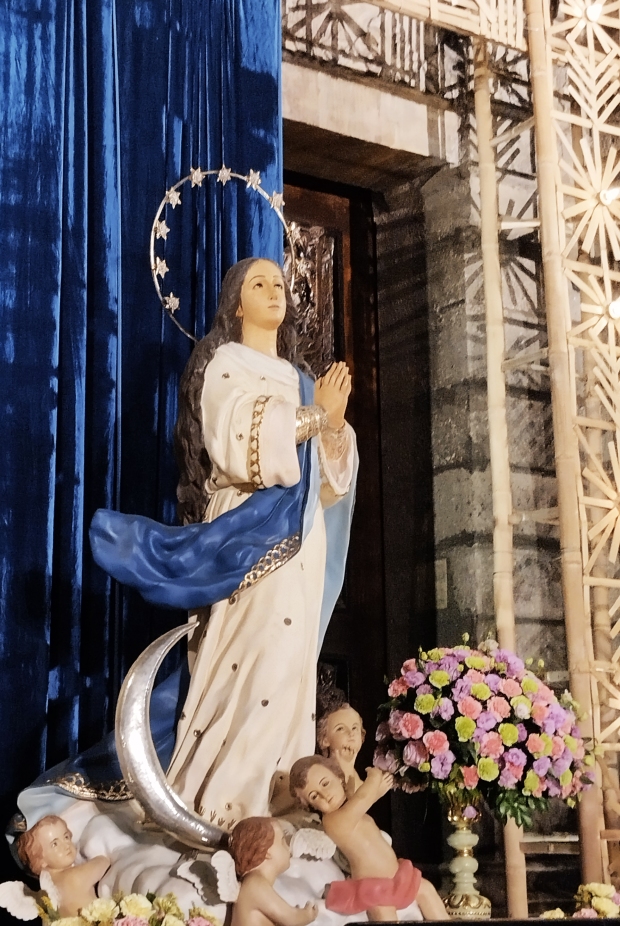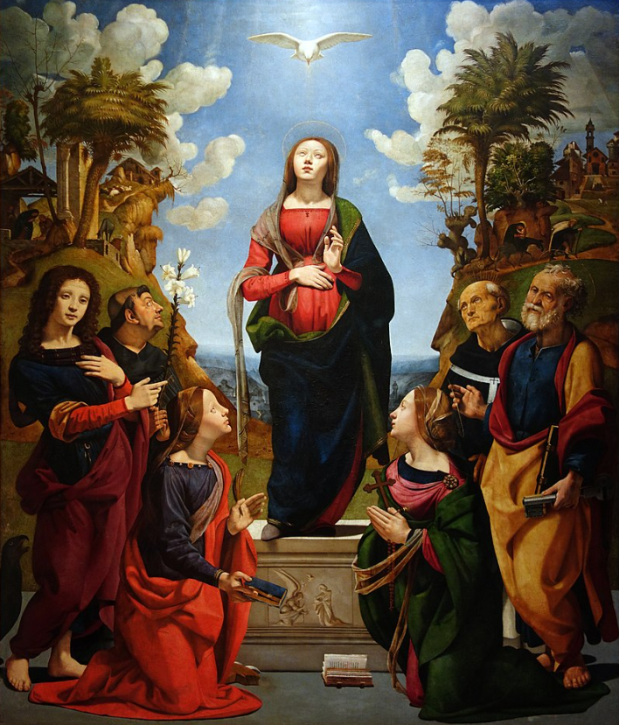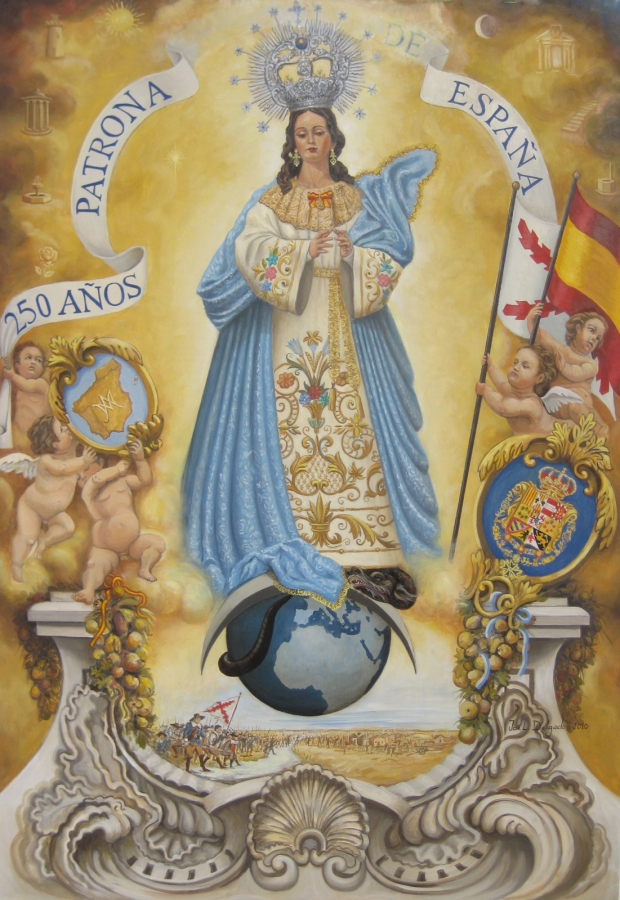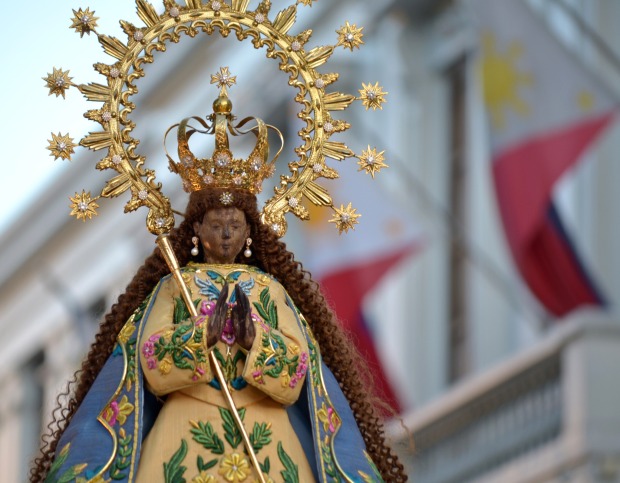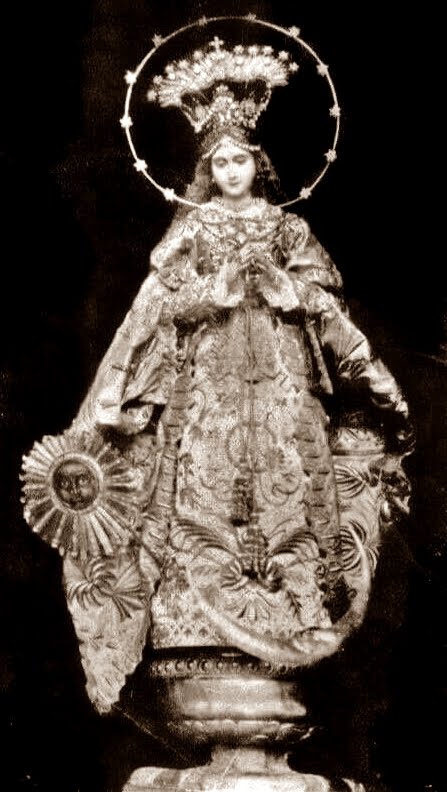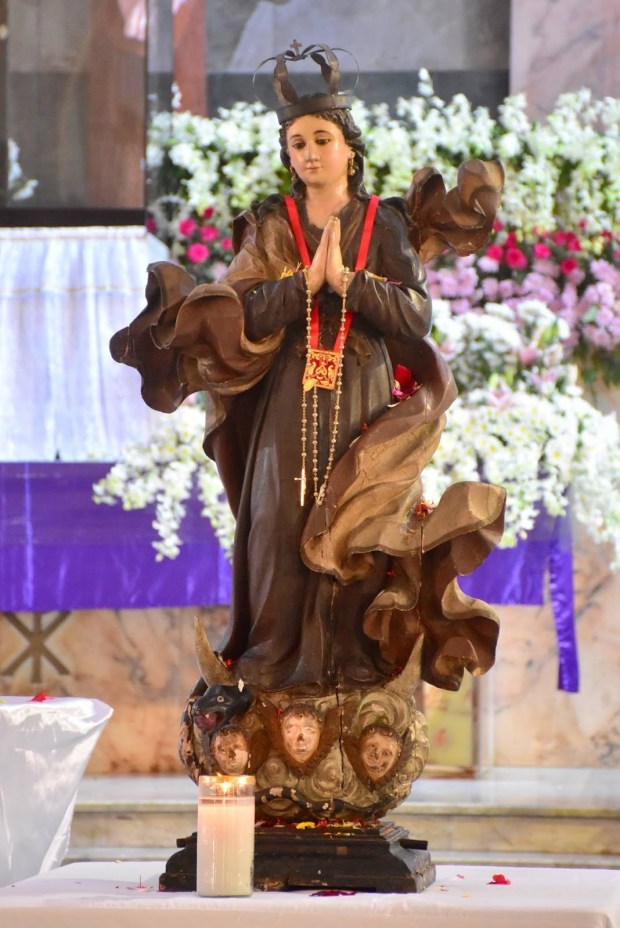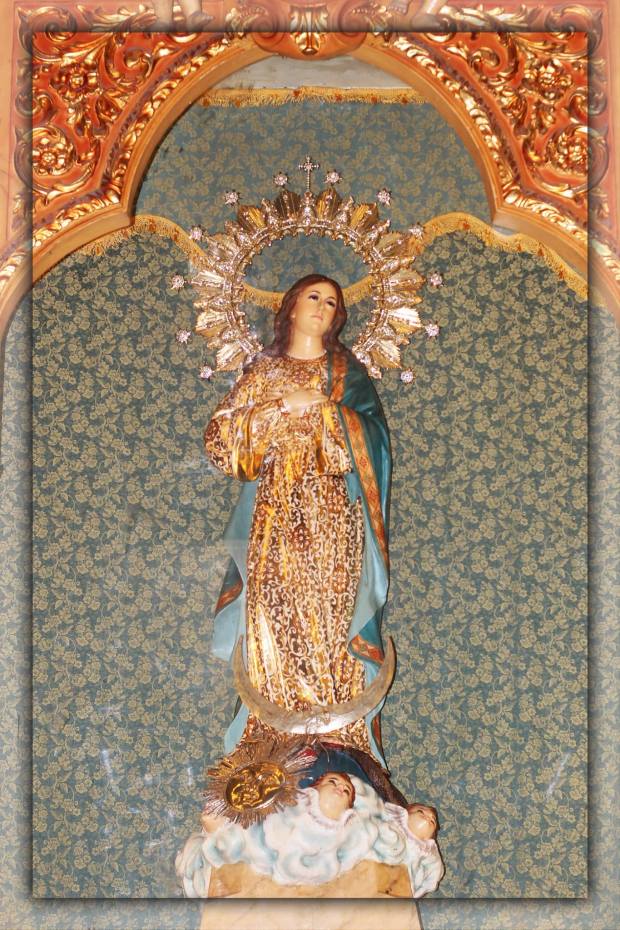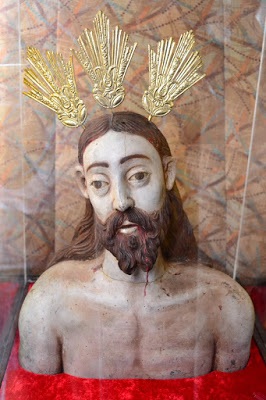
If we can recall one of the previous blogposts here in Pintakasi about the venerated images of Intramuros that survived the ravages of the Second World War either remained or left Intramuros either as venerated images in the relocated churches of the religious orders who brought them to the country or commissioned locally by our artisans or in some cases, museum pieces.
As its fitting follow up on this unexpected trilogy on the Catholic Faith in Old Intramuros (Due to the response on the first article regarding the surviving images of Old Intramuros), we now focus on the images that were unfortunately destroyed during the Liberation of Manila. These images enjoyed much cult following during the Spanish regime and the Pre-War period and became part of the lives of every Manileños for centuries until the atrocities of the Second World War. These images may be gone forever, yet their impact can’t be forgotten for these images and their respective devotional following created a lasting effect that shaped our present climate of our own popular piety.

Nuestra Señora del Santismo Rosario (The First image)
Provenance: Iglesia de Santo Domingo
Before the famous image of Nuestra Señora del Santisimo Rosaio – La Naval de Manila, there was already a existing image of a Santo Rosario that was brought by the Dominicans from Mexico in 1587. The Mexican image was of one piece of wood and stood a meter and half high on a 30 centimeter tall pedestal. Until the 1863 earthquake, a relic from the tilma of Our Lady of Guadalupe is kept concealed in a hallowed-out portion at the back of the statue.
The first image was later replaced in the 1590’s by the one with ivory parts known today as the La Naval, but devotees requested that the wooden image be relocated somewhere where she could still be venerated. Thus the image was placed on the facade of the Iglesia de Santo Domingo and a light was provided by night thanks to a perpetual donation of ten pesos each year. The image survived the destruction of Santo Domingo Church in Intramuros by earthquakes and fires yet she was lost during the bombings of 1941.
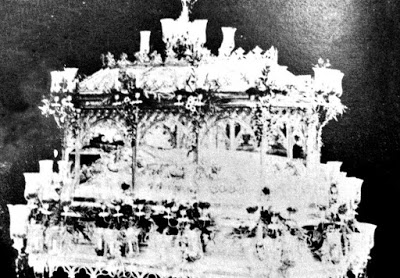
Señor Yacente de Intramuros
Provenance: Iglesia de Santo Domingo
One of the earliest known Holy Week images in the country is that of the image of the Señor Yacente (More popularly known as the “Santo Entierro”) of old Santo Domingo Church in Intramuros. Though the origins of this image is unknown yet it garnered a devotional following in Old Manila and the “Hermandad del Santo Entierro y Virgen de la Soledad”, the Hermandad in charge of the Good Friday procession of the old Iglesia de Santo Domingo was given formal approval by Pope Clement VIII in 1598.
The image is usually decked on his finest calandra where jewels from different affluent families decorates the calandra. The Solemn and Somber Good Friday processions are led by the Dominican Order, the Beatas of Beaterio de Santa Catalina, students of Colegio de San Juan de Letran and University of Santo Tomas, the military and the high ranking officials, including the Capitan General of the colony. The image is also accompanied by the different banners and symbols of the Passion and a flank of saints present in the Passion narrative and the Señor Yacente is the last image of the grand Good Friday procession of the Walled City. When the original image was destroyed during the War, a replica of the Señor Yacente later commissioned and it is being kept and it is currently used for Good Friday Processions at the present Santo Domingo Church in Quezon City.

San Francisco de las Lagrimas
Provenance: Real Monasterio de la Inmaculada Concepcion y Sta. Clara de Asis
The miraculos image of San Francisco de las Lagrimas was brought to the Philippines in 1577, was venerated in a chapel of the Royal Monastery of Santa Clara.. During the earthquakes of 1645, Don Alonso Cuyapit, an indio principalla of Dilao (now Paco), had taken it to his house to use in the processions of the Franciscan Third Order of the area, and there this statue was seen away from its niche, kneeling at a window overlooking Manila, and shedding tears through all four days of earthquakes. Many people saw this, and wet their handkerchiefs in its tears, hence the title “De Las Lagrimas”. A procession was formed to take the statue back to Manila, at which point the quakes ceased. A wind came up, but the candles did not go out.
The image of San Francisco was declared miraculous and St. Francis of Assisi was named patron
and protector against earthquakes. In 1742, when a galleon failed to arrive, this statue, now called San Francisco de las Lagrimas, was taken out in procession, accompanied by the crosses of all the parishes, the orders, the Real Audiencia, and the Governor. San Francisco de las Lagrimas was also known as the Seraphic Protector of Manila where during the invasion of the Chinese pirate Limahong, the enemies saw San Francisco holding a flaming sword and the enemies ran away from this vision.
San Francisco de las Lagrimas was considered as one of the three palladiums of the City of Manila together with Santo Cristo del Tesoro of Colegio de Santa Isabel, and Nuestra Señora del Rosario- La Naval de Manila of Iglesia de Santo Domingo.
The image, along with its companion Santa Clara image, were destroyed during the war yet interestingly, there were some images of St. Francis of Assisi from some Franciscan Churches, notably in the Shrine of St. Anthony of Padua in Bustillos, Sampaloc, Manila that were patterned after the lost San Francisco de las Lagrimas so that the legacy of this once mighty protector of Manila cannot be forgotten.
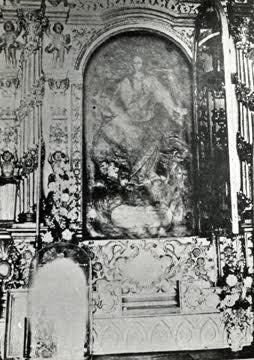
Nuestra Señora de la Porteria
Provenance: Iglesia de San Francisco
In a Franciscan convent structure, one of the most prominent aside from its austere atmosphere is the “porteria”. A porteria is like a reception area that is located in the netrance of the convento. In the porteria, a friar porter is assigned asa gatekeeper of the convento who welcomes visitors, travellers, a temporary shelter for the dying (complete with medical and other provisions) and provided alms for the poor. In every Franciscan Porter, an image of the Immaculate Conception, whether it is a painting or a statue, is a prominent feature of the area.
The painting of the Immaculate Conception in the convento of the Franciscans in Intramuros later became known as Nuestra Señora de la Porteria. In the course of centuries, people who visited the porteria of the convento, whether a pilgrim, a traveller, a friend of the order, a poor beggar or a dying person, would pray to the Virgin of the Porter in their different needs and miracles were later attributed to her intercession.

La Inmaculada Concepcion de los Padres Franciscanos
Provenance: Iglesia de San Francisco
In the early days, the Church of Old San Francisco of Intramuros was once the one of the centers of the devotion to the Immaculate Conception, along with that of the Manila Metropolitan Cathedral and the beautiful image was one of the most venerated in the country. The image was once known as the “festejada” of the Walled City for the archipelago was placed under the patronage of the Immaculate Conception.
The celebration of her feast is known to be a grand a huge festivity that would rival that of the Santo Rosario of the Iglesia de Santo Domingo with fairs, bands, bullfights, theater performances and a grand procession to cap the festivities.
Although the image was destroyed during the War, the memory of the grandeur of the Solemnity of the Immaculate Conception continues to live on with the annual Grand Marian Procession held every first Sunday of December organized by the Cofradia de la Inmaculada Concepcion and the Intramuros Administration. A new festejada image was also commissioned that takes part of the grand festivities within the Walled City.

San Antonio de Padua de Intramuros
Provenance: Iglesia de San Francisco
The devotion to the miraculous and universal saint flourished when the Italian friars took over the Church and Convent of San Francisco from the Spanish friars when tehy were expelled during the Revolution.The devotion was proven to be popular due to the numerous miracles that were atributed to his intercession, especially during the novena days and wil culminate on his feast day, June 13. The popularity of the devotion reached its peak when Manila became the center of the and all of its ancient grandeur celebrates the 700th year anniversary of the saint’s canonization marked by a monument dedicated to the saint in front of San Francisco Church.
When the old San Francisco Church was destroyed during the Libertion of Manila, the devotion was transferred to its current location in the chapel of the Venerable Third Order of Saint Francis in Bustillos, Sampaloc, Manila and a faithful replica of the destroyed image is currently enshrined and the devotion continued to flourish.
As for the monument in front of the Old San Francisco Church, the monument was transferred to the current Santuario de San Antonio in Forbes Park, Makati City that can be seen up to this day..

La Divina Pastora de Intramuros
Provenance: Iglesia de Nuestra Señora de Lourdes
The Capuchin Order arrived in the shores of Manila in 1882 first as a satellite area for their missions in the Oceania islands until they later formally settled in Intramuros years later and on May 8, 1892, the order’s first chapel opened by the Capuchins to the public which was initially dedicated to La Divina Pastora – the Patroness of the Order where a Capuchin in Seville saw the Blessed Virgin as the Divine Shepherdess in 1703 and propagated the devotion all over Spain and its colonies as part of their missions.
This image of La Divina Pastora depicts a seated Blessed Virgin Mary with the Child Jesus with a sheep which gives an impression that both Mother and Child are tending the sheep. Veery little is written about this devotion in Intramuros due to the fact that the devotion to Nuestra Señora de Lourdes, which was originally intended as a grotto image, flourished due to the miracles that were attributed to her.

San Ignacio de Loyola de Intramuros
Provenance: Iglesia de San Ignacio
The glorious image of San Ignacio de Loyola, Founder of the Society of Jesus, more popularly known as the Jesuits, was carved by Manuel Flores and was enshrined in the retablo mayor of the old San Ignacio Church. Since his enthronement, San Ignacio gained much devotional following with the Spaniards and the students of Ateneo Municipal in the Walled City.
The feast of San Ignacio takes a militant tone. The Ateneo cadet corps usually has an exhibition during this feast day, and the Marcha de San Ignacio, a Basque hymn, is sung in military cadence by all. In fact, the feast day Mass was also labeled as the “Basque Mass” because many of the Basque families of Manila hear this fiesta Mass in honor of one of the Pais Vasco’s most celebrated sons. The Elizaldes, Aboitizes, Echevarrias, the Luzarragas, Ynchaustis would be in attendance. Though the image of San Ignacio was gone forever, the Feast of San Ignacio de Loyola is still being celebrated with much solemnity in different Jesuit mission churches, schools and universities in the country.

Sagrado Corazon de Jesus de Intramuros
Provenance: Iglesia de San Ignacio
The devotion to the Sacred Heart of Jesus was introduced to the Philippines by the Jesuit Order in 1856 and the Church of San Ignacio in Intramuros became the center of Friday devotions to the Sacred Heart. The first locally made image of the Sacred Heart was carved by Manuel Flores and was prominently enshrined in San Ignacio Church’s side altar and numerous miracles were attributed to the Sacred Heart.
Years later, in 1872, the devotion was further propagated when the Apostleship of Prayer was established in the country years after it was founded in France in 1884 to “Offer everything you are doing each day in union with the Heart of our Lord for what He wishes, the spread of the Kingdom for the salvation of souls.” as described by its founder, Rev. Fr. Francis X. Gautrelet, SJ. The first three centers of the Apostleship, namely Ateneo de Manila, Sta. Isabel College and the Colegio de la Concordia, all located in Manila. Since then, the Association has expanded its network and membership throughout the entire archipelago. When San Ignacio was bombed, the center of devotion to the Sacred Heart of Jesus was later transferred to the National Shrine of the Sacred Heart of Jesus in Makati City.

El Glorioso San Jose de Manila
Provenance: Iglesia de San Nicolas de Tolentino
Before Wednesdays are associated to Baclaran, it was then known as the day dedicated to St. Joseph in Manila. The Recoleto church was also an important shrine to San Jose, and throughout the year, several celebrations were held in his honor. There was a March devotion to the saint, and from November 18-26, the Recoletos came up with their biggest fiesta of the year, the solemnity of San Jose, highlighted with a pageant to honor the nuptials of Mary and Joseph.
There were two images of San Jose that were kept in San Nicolas Church, the altar image and the richly dressed processional image, showing the saint holding the Child Jesus on a base adorned with angels, occupied one of the many rococo altars that lined both sides of the Recoleto church. Regular masses were dedicated to the saint every Wednesday at 6:30 pm attended with the members of a cofradia dedicated to San Jose and devotees wearing green dresses or shirts with a yellow rope belt or cincture on their waists.
When San Nicolas and the statues of St. Joseph were destroyed, the devotion to San Jose in Old Intramuros died down yet it is still kept alive in different parishes in the country like those in Laguna where Wednesdays are still observed in his honor and some devotees were seen wearing green dresses and yellow rope.

Señor Santo Cristo de la Pacencia de Manila
Provenance: Iglesia de San Nicolas de Tolentino
The dark image of the Señor Santo Cristo de la Pacencia was brought by the Recoleto Fathers from Mexico in an unknown date and was venerated in the Old San Nicolas Church. Sculpted by Juan de Araus of Aragon, Mexico, this image depicts a dark skinned Christ, seated right after he was scourged and crowned with thorns with his hands on his chin contemplating on his passion and death. In the annals of the Order, the mentioned on some occasions with one about his enthronement in San Nicolas as a replacement image of Nuestra Señora de la Salud when the image returned to her own Church in San Juan de Bagumbayan. However, the image of La Salud later returned to the Walled City in 1762 when the British troops destroyed San Juan de Bagumbayan and stayed in San Nicolas for the next centuries until the Second World War.
The Señor de Pacencia enjoy a cult following, along with the Señor Nazareno of the same church that both images were once the center of attention and devotion especially on the Palm Sunday processions in Intramuros. The cult of the Señor de la Pacencia became widespread in the islands that almost all parishes, oratories and home altars had an image of the La Pacencia and became one of the staple images that can be found in Holy Week processions across the country.
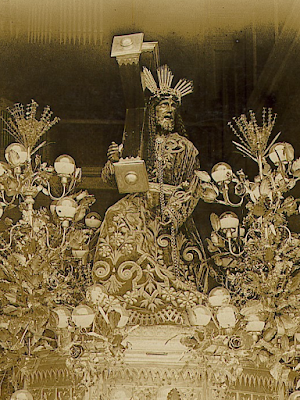
Nuestro Padre Jesus Nazareno de Intramuros
Provenance: Iglesia de San Nicolas de Tolentino
For some of the faithful who are familiar with the story of the Black Nazarene of Quiapo, the Quiapo image is a replica of this older image of the Nazarene that was enshrined in the Old Iglesia de San Nicolas.
This image was known to be the Nazareno of the elites while the Quiapo image is for the masses was available for physical veneration by devotees, this image on the other hand was always kept in the retablo menor away from crowds, bringing it out only on Palm Sunday for its Holy Week procession. This image is known to have a set jewels of precious stones on its regalia from diamond encrusted Tres Potencias, silver shoes, silver andas and ramilletes, robes embroidered with gold thread and only wears purple robes.
A replica was later commissioned which gained much popularity, most especially for the Indios. Due to the increase of number of Indios who are entering the Walled City, for this purpose, which was considered alarming at that time, Archbishop Basilio Sancho de Santas Justa y Rufina mandated the transfer of this image, which is now known as the famous Nuestro Padre Jesus Nazareno of Quiapo to the Parish of St. John the Baptist in Quiapo, Manila in the late 1787 where it has rested on its altar ever since as a living memory of the old Nazareno of the Walled City.

Sta. Lucia de Manila
Provenance: Iglesia de San Nicolas de Tolentino
The image of Santa Lucia of Old San Nicolas Church became the focal point of devotion to the patroness of those who have eye problems in Manila and its surrounding arrabals and provinces. The image of this virgin and martyr is usually garbed in red and crowned with gold. On her Feast day, December 13, everyone would flock San Nicolas to hear fiesta mass in her honor.
In the morning of the feast, one will find the streets crowded with sun-burned folk in peasant attire: camisachino and balintawak. They had come down from the hill-towns of Rizal Province to pay homage to Santa Lucía, The patio of the Recollects was transformed into a village market fair, and there you could buy fresh eggs, fat fowl, wild honey, fruit in season, native sweets, and candies and preserves, puto seco, and polvoron, suman sa lejia, and other delicacies you might need for the Christmas table and at the same time, the folks would earn some Christmas money. The annual fiesta fair will last until noon and when devotees would return to San Nicolas, the fair was already over and the surroundings were back to its usual silence.
Although the image was already destroyed, the devotion was silently transferred to San Sebastian Minor Basilica where a new image is currently enshrined and the townsfolk from Rizal province would still visit Sta. Lucia as what thir forefathers did, even with the absence of the fair.

San Nicolas de Tolentino de Intramuros
Provenance: Iglesia de San Nicolas de Tolentino
The first Recoleto missionaries came to the Philippines with the intention to dedicate the first convent on Filipino soil to the glorious San Nicolas de Tolentino – the First Saint of the Augustinian family. Upon arriving in Manila in 1606, however, they came to know that the Augustinians had already an altar in his honor. Out of finesse, the Recollect Fathers desisted from this purpose. Yet in their simplicity, the tried to solve the problem by drawing lots. Pleasantly surprised, the good Fathers witnessed that for three consecutive times, the name of San Nicolas came out first. Naturally, they names the Saint as Patron not only of the first house but also of the while Province of the Order. An image of San Nicolas was later enthroned in the Church and became a center of pilgrimage since then. Numerous favors have been recorded through the intercession of this charitable Saint, both individually and collectively.
The original convent and Church of San Nicolas was destroyed and razed that the Superior Provincial was transferred to Spain and the Vice Provincial has been residing at San Sebastian convent until it was decided to have an independent and autonomous residence for the Central Office of the Recollects in the Philippines and China.
In 1970, the Recollect Fathers moved to their new location in Quezon City where they built the Motherhouse and it’s adjacent Church was erected on December 23, 1971. Both the house and the Church are meant to be a living remembrance of the convent and the Church in Intramuros. The devotion to San Nicolas was also resumed and his feast is still celebrated with much solemnity with the distribution of the famed “Panecillos de San Nicolas” to the faithful.
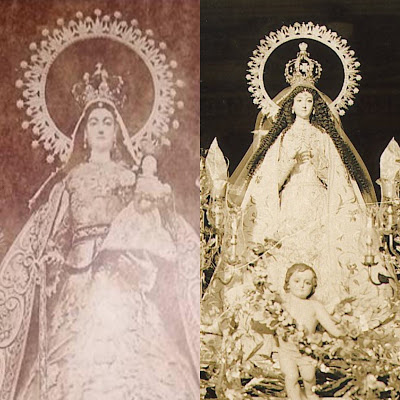
Nuestra Señora de la Consolacion y Correa de los Padres Recoletos
Provenance: Iglesia de San Nicolas de Tolentino
Before the Second World War, there in fact 2 venerated images of Nuestra Señora de la Consolacion y Correa existed within the Walled City, the La Consolacion Coronada of San Agustin Chruch of the Augustinian Friars and the La Consolacion of San Nicolas de Tolentino of the Augustinian Recollects.
The image of Nuestra Señora de la Consolacion y Correa of old San Nicolas Church was one of the early images brought by the Augustinian Recollect Friars in the country joining the roster of Nuestra Señora del Carmen de San Sebastian, Nuestra Señora dela Salud, Nuestra Señora del Pilar of Imus and the famed Nazareno images of Intramuros and Quiapo. The fiesta of the Virgin of Consolation is celebrated with solemnity with the image being brought out of procession in her beautiful carrozza. On some occassions, the image goes out alone without the Child Jesus on some occassions as evident in the old photograhs of the image mounted on her carozza.
When the image was destroyed during the War, only the doce estrellas survived and it later became part of the canonical reglia of Nuestra Señora del Carmen de San Sebastian that can still be seen today. At present, a parish dedicated to La Consolacion of the Recollect Order can be found at Mira Nila Homes, Quezon City.
Post Mortem Commentary
One cannot help but to be saddened with the loss of these holy treasures that played different roles in our history. These venerable images became silent witnesses to our people’s faith, life story and everyday struggles who lived or visited the famed Walled City. As we learn the stories of these images, one may realized the impact they left in our devout popular consciousness and its continuous legacy, in some cases endurance either by the continuity or the unconscious reintroduction of the devotion that continues to shaped the Catholic faith and culture in the islands. May this anthology of the short history of these lost relics of our faith may serve as a call for a proper preservation and documentation of our religious images and its accompanying devotions and traditions that surrounds it for these tangible and intangible treasures gives us a picture of our past that later helped shaped our national identity.
References:
Aguilar, Antonio Martinez, OAR, San Nicolas de Tolentino (A biographical sketch), San Nicolas de Tolentino Parish, Quezon City, 1972.
Aviado, Lutgarda, Madonnas of the Philippines, Manlapaz Press, Quezon City, 1972.
Gutay, OFM, JF. Church of the Our Lady of the Angels in Intramuros, Manila. OFM Philippines Archives. Order of Franciscan Minors in the Philippines. Retrieved 24 November 2014.
Intramuros Administration, The Virgins of Intramuros and suburbs, Intramuros, Manila, 1982.
Rubia, Rommel, OAR, La Salud: the Black Virgin of Health, Recoletos Communications, Order of Augustinian Recollects, Province of St. Ezekiel Moreno, Quezon City, 2016.
Sanchez, Francisco,. La Virgen Maria Venerada en sus Imagenes Filipinas, Manila: Imp. De Santos y Bernal., 1904.
Credits to the owner of the photos that were utilized for this blogpost.
+AM+DG+

